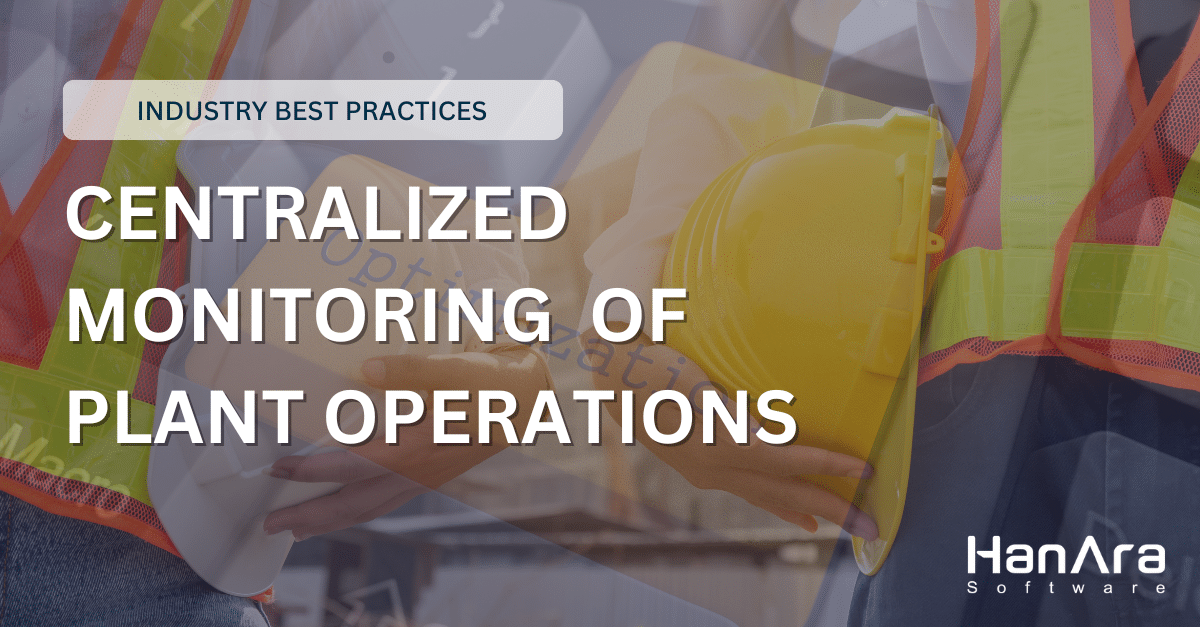The pursuit of optimized plant operations remains a critical yet elusive goal for many management teams. Plant operational inefficiencies can lead to significant productivity losses and missed opportunities for cost savings. As we navigate increased supply chain and production complexities alongside the demand for sustainable operations, streamlined, data-informed plant management has never been more urgent.
The Challenge: Overcoming Operational Hurdles
Plant managers face numerous obstacles in their quest for operational excellence:
- Time and budget constraints
- Skilled workforce shortages
- Technology integration challenges
- Communication silos between teams and departments
- The complexity of managing multi-site operations
One method to overcome these challenges and improve operational efficiency and responsiveness is combining a data management solution with a Centralized Monitoring Center (CMC). A CMC is a dedicated facility or operational unit within an organization that oversees and manages the operations of multiple plants, sites, or systems from a single, centralized location. Organizations can improve operational efficiency and responsiveness by leveraging centralized data management and fostering direct communication between CMC and site teams.
Centralized Plant Monitoring: Five Keys
Drawing on our experience and industry best practices, HanAra has identified five key elements that help plants achieve the often-elusive goal of optimization with a CMC:
1. Establish a Centralized Monitoring Center
A CMC is a dedicated operational hub that oversees and manages multiple plants or systems from a single location. This centralized approach serves as the nerve center of your operations, offering:
- Integrated management of distributed systems
- Rapid analysis and response to alerts
- Real-time monitoring of all facilities
- Foundation for predictive maintenance strategies
By centralizing monitoring, a CMC enhances overall operational efficiency and enables quicker, more informed decision-making across your entire network of facilities.
Actionable Step: if your organization does not currently have a CMC, identify a suitable location and allocate subject matter expert (SME) resources for your CMC. Start small with a pilot program focused on one critical system before scaling up.
2. Choose the Right Technology
A robust data analysis system transforms the CMC into a command center, regardless of where the issue occurs. Subject matter experts, management, and department heads no longer need to be physically present at the site of the issue; they can access the same information remotely and collaborate directly with on-site personnel to resolve problems. The right data analysis technology also improves data visualization through intuitive graphics, providing immediate insight into plant status and potential issues. Faster understanding at the CMC leads to quicker responses in the field.
When selecting your technology partner, consider the following features and support:
- Secure data monitoring available anytime, anywhere
- Centralized integration and collection of sensor data for easy analysis
- User-friendly solutions with dashboards and reporting for easy visualization
- Quick access to real-time and historical data
- Comprehensive training programs and a dedicated solution support team
Actionable Step: Evaluate potential technology partners based on the above criteria. Request demos and trial periods to ensure the solution meets your specific needs.
3. Implement Plant Operational Best Practices
While each plant or fleet has unique challenges, some commonalities can be proactively addressed. Leverage internal and external resources to help develop a best practices guide based on your plant and similar facilities. Key considerations include:
- Personnel: Identify and document the expertise required for various situations, as well as the locations and roles of your experts.
- Location: Ensure that network communication is configured for collaboration between the CMC and facilities, and plan for future expansion or installations.
- Detailed Operational Plan: Meticulous planning can save significant time during an issue. Your operational plan should outline the CMC’s role during normal operations, start-up and shutdown phases, and emergency scenarios. For example, the CMC monitors data during regular operations and plans predictive and preventive maintenance.
Actionable Step: Conduct a thorough audit of your current practices and identify gaps. Develop a roadmap for implementing these best practices over the next 6-12 months.
4. Staffing
Setting up a CMC involves two phases: the pilot phase and the extended operation phase. In the pilot phase, the focus is on identifying issues and improving operational effectiveness within the department. The extended operation phase requires collaboration across the company and with external partners.
Your facility will need staff for monitoring and predictive analytics activities. Ensuring that your CMC is adequately staffed and personnel are thoroughly trained is crucial. Creating a CMC doesn’t necessarily mean hiring additional staff; with intuitive technology and on-site vendor training, existing personnel can effectively manage the CMC.
Actionable Step: Assess your current team’s skills and identify training needs. Develop a phased staffing plan that aligns with your CMC implementation timeline.
5. Centralized Monitoring in Action
Once your CMC is operational, it’s essential to define the parameters and functions of the installed tools. For facility monitoring, choose items to manage based on the frequency of pending issues. Analyze data to identify trends and organize these trends to generate actionable notifications.
Leverage a predictive analytics system to provide early warnings, allowing you to take proactive measures to minimize damage and maintain stable plant operations. Your analytics system should offer real-time monitoring, programmed anomaly detection, and automated notifications to improve reliability and availability.
Actionable Step: Start by monitoring your most critical systems. Set up automated alerts for key performance indicators (KPIs) and gradually expand your monitoring scope.
How We Help
At HanAra, we’re committed to empowering our customers to overcome challenges and optimize their plant operations. Our cutting-edge solutions and expert support can guide you through every step of your digital transformation journey, enhancing your operational reliability and driving sustainable growth.
Ready to take the next step in your plant optimization journey? Contact us today for a personalized consultation and discover how we can help you unlock your plant’s full potential.

